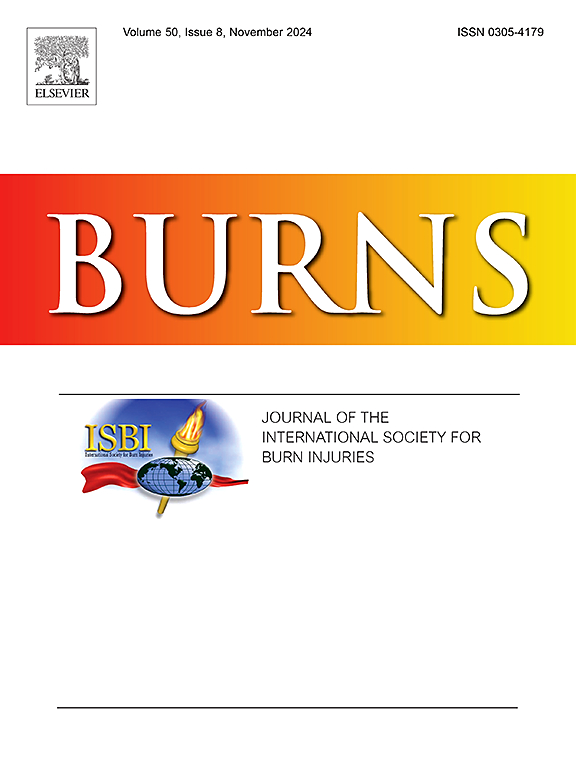Adding fuel to the fire: The impact of alcohol consumption on outcomes after hand burns – A retrospective cohort study
IF 3.2
3区 医学
Q2 CRITICAL CARE MEDICINE
引用次数: 0
Abstract
Introduction
Alcohol abuse is a common comorbidity among burn patients. Elevated blood alcohol levels lead to increased inflammation, delayed wound healing, and prolonged recovery. However, knowledge about outcomes in hand burn patients is limited. Our study aims to analyze the association between alcohol consumption and its impact on outcomes of patients suffering hand burns.
Methods
A retrospective analysis of patients admitted with hand burns from 2007 to 2024 was conducted. Patients were categorized into two groups based on blood alcohol content (BAC): low (<100 mg/dL) and high (≥100 mg/dL). Data collected included demographics, comorbidities, and outcomes.
Results
Ninety-five patients (85.3 % male; mean age 43.8 ± 15.9 years) were included. Most hand burns were bilateral (58.9 %), and 7.4 % were isolated. No significant differences in demographics, comorbidities, or ICU admission rates were observed between BAC groups. Full-thickness burns were significantly more frequent in the high BAC group (15.7 % vs. 2.3 %, P = 0.035). The high BAC group had a longer hospital stay (22.3 ± 23.1 vs. 13.6 ± 16.2 days, P = 0.038), higher rates of inpatient rehabilitation (50.0 % vs. 24.3 %, P = 0.023) and poorer functional outcomes (Quick DASH, 19.0 ± 4.0 vs. 17.1 ± 4.5, P = 0.033).
Conclusions
Elevated BAC in hand burn patients is associated with longer hospital stays, more severe burn depth, and worse functional outcomes. Implementing targeted interventions, such as alcohol withdrawal management and enhanced therapy protocols, could improve patient outcomes in this high-risk group.
火上浇油:酒精消费对手烧伤后结果的影响——一项回顾性队列研究
酒精滥用是烧伤患者常见的合并症。血液中酒精含量升高会导致炎症加剧,伤口愈合延迟,恢复时间延长。然而,对手部烧伤患者的预后了解有限。我们的研究旨在分析饮酒与其对手部烧伤患者预后的影响之间的关系。方法对2007 ~ 2024年收治的手部烧伤患者进行回顾性分析。根据血液酒精含量(BAC)将患者分为两组:低(<100 mg/dL)和高(≥100 mg/dL)。收集的数据包括人口统计学、合并症和结果。结果95例患者(85.3 %男性;平均年龄43.8 ± 15.9岁)。大多数手部烧伤为双侧(58.9 %),7.4 %为孤立性烧伤。BAC组在人口统计学、合并症或ICU入院率方面没有显著差异。高BAC组全层烧伤明显更频繁(15.7 % vs. 2.3 %,P = 0.035)。酒精含量高的组较长的住院时间(22.3 ± 23.1 vs 13.6 ± 16.2天,0.038 P = ),较高的住院病人康复(50.0 % 24.3 vs % P = 0.023)和贫穷的功能性结果(快速冲刺,19.0 ± 4.0和17.1 ± 4.5,P = 0.033)。结论手部烧伤患者BAC升高与住院时间延长、烧伤深度加重和功能预后恶化有关。实施有针对性的干预措施,如酒精戒断管理和强化治疗方案,可以改善这一高危群体的患者预后。
本文章由计算机程序翻译,如有差异,请以英文原文为准。
求助全文
约1分钟内获得全文
求助全文
来源期刊

Burns
医学-皮肤病学
CiteScore
4.50
自引率
18.50%
发文量
304
审稿时长
72 days
期刊介绍:
Burns aims to foster the exchange of information among all engaged in preventing and treating the effects of burns. The journal focuses on clinical, scientific and social aspects of these injuries and covers the prevention of the injury, the epidemiology of such injuries and all aspects of treatment including development of new techniques and technologies and verification of existing ones. Regular features include clinical and scientific papers, state of the art reviews and descriptions of burn-care in practice.
Topics covered by Burns include: the effects of smoke on man and animals, their tissues and cells; the responses to and treatment of patients and animals with chemical injuries to the skin; the biological and clinical effects of cold injuries; surgical techniques which are, or may be relevant to the treatment of burned patients during the acute or reconstructive phase following injury; well controlled laboratory studies of the effectiveness of anti-microbial agents on infection and new materials on scarring and healing; inflammatory responses to injury, effectiveness of related agents and other compounds used to modify the physiological and cellular responses to the injury; experimental studies of burns and the outcome of burn wound healing; regenerative medicine concerning the skin.
 求助内容:
求助内容: 应助结果提醒方式:
应助结果提醒方式:


